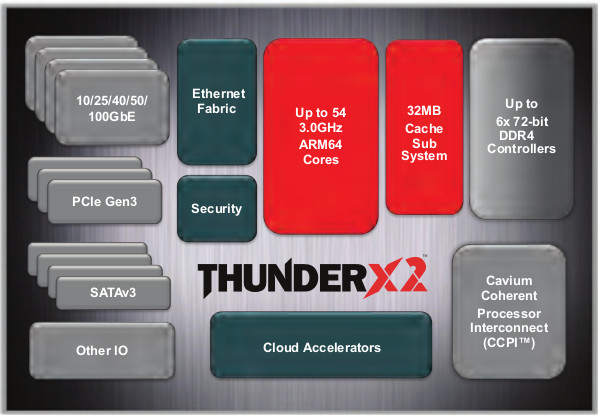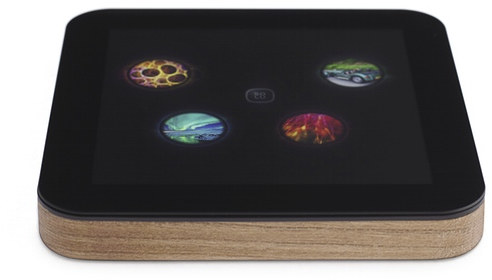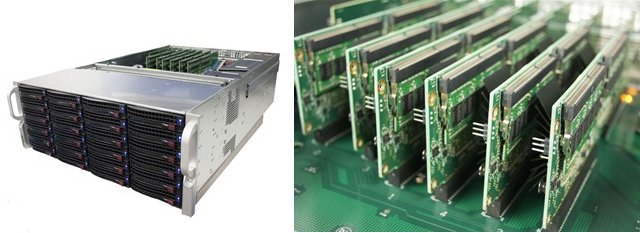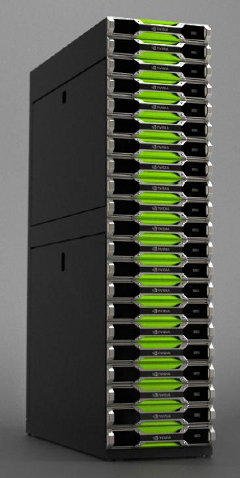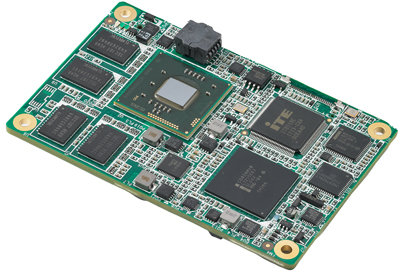Cavium announced their first 64-bit ARM Server SoCs with the 48-core ThunderX at Computex 2014. Two years later, the company has now introduced the second generation, aptly named ThunderX2, with 54 64-bit ARM cores @ up to 3.0 GHz and promising two to three times more performance than the previous generation. Key features of the new server processor include: 2nd generation of full custom Cavium ARM core; Multi-Issue, Fully OOO; 2.4 to 2.8 GHz in normal mode, Up to 3 GHz in Turbo mode. Up to 54 cores per socket delivering > 2-3X socket level performance compared to ThunderX Cache – 64K I-Cache and 40K D-Cache, highly associative; 32MB shared Last Level Cache (LLC). Single and dual socket configuration support using 2nd generation of Cavium Coherent Interconnect with > 2.5X coherent bandwidth compared to ThunderX System Memory 6x DDR4 memory controllers per socket supporting up to 3 TB RAM in […]
Solu Touch-Enabled Portable mini PC Runs a Cloud-linked OS on Nvidia Tegra K1 (Crowdfunding)
Solu Machines, has startup based in Finland, as decided to re-invent the computing experience. To achieve this they’ve created a battery powered mini PC based on Nvidia Tegra K1 processor and 4GB RAM, included a touch screen on the top cover that can be used as a tablet on the go, and as a touchpad when connected to a monitor, while creating a new OS called SoluOS with a new type of user interface and that stores lots of the data in the cloud, yet allows the device to run offline, and there’s more… Solu mini PC specifications: SoC – Nvidia Tegra K1 4-Plus-1 ARM Cortex-A15 CPU @ 2.3GHz with 192-core Kepler GPU System Memory – 4GB LPDDR3 Storage – 32GB “cache capacity” Display – 1440 x 1440, 450ppi, with an edge-to-edge touch Video Output – Support for up to 4K monitors apparently via USB type-C connector Connectivity – Dual-band […]
Boston Viridis 2.0 and AAEON CRS-200S-2R ARM Based Servers Powered by Calxeda Quad core Cortex A15 SoC
Calxeda unveiled its new ECX-2000 Server-on-a-Chip (SoC) at ARM Techcon 2013. Calxeda new chipset features 4 cortex A15 cores, support up to 16GB RAM, and thanks to the move from Cortex A9 to Cortex A15 supports hardware virtualization. I’ve stumbled across two new servers powered by ECX-2000: Boston Viridis 2.0 and AAEON-CRS-200S-2R. Let’s have a look Boston Viridis 2.0 The successor of Boston Viridis powered by Calxeda ECX-1000 quad core Cortex A9 SoC, Viridis 2.0 features six ECX-2000 cards, with each card hosting two four-core SoCs @ 1.8GHz, and consuming as little as 6 watts of power. The server runs Ubuntu 13.10 operating systems, and OpenStack Havana platform, and would typically be used for cloud computing, distributed storage, and virtualization. Viridis 2.0 is a 4U ARM microserver that, and the company claims this can allow up to 1000+ servers in a rack, or about 1.5PB of data storage per rack. […]
Nvidia GRID Platform, Tegra 4 Processor and Project SHIELD Game Console at CES 2013
CES 2013 has finally started, and Nvidia has had a pretty amazing keynote with some PC gaming announcements such as “GeForce Experience” which is a piece a software that can configure your games settings automatically based on your PC hardware (e.g. processor and GPU), and 3 cloud and mobile devices announcements: Nvidia GRID Platform – Cloud Gaming Server with 240 Nvidia GPUs. Nvidia Tegra 4 – Nvidia 4 cores Cortex A15 , 72 GPU and SDR modem SoC for tablets and smartphones. Nvidia Project Shield – Game console with a 5″ display powered by Tegra 4 that can also act as a game controller, and play PC games on your TV. Nvidia GRID Platform NVIDIA GRID Cloud Gaming Platform is comprised of 20 GRID server per rack with a total of 240 Nvidia GPU capable of 200 TFLOPS or the equivalent of 700 Xbox 360. Nvidia GRID render 3D graphics […]
Dell Announces Copper ARM Servers Based on Marvell ARMADA XP SoC
It looks like 2012 will be the year of ARM servers. After previous announcements of ARM servers based on Calxeda and Applied Micro SoC, Dell has just announced its own “Copper” ARM servers powered by Marvell ARMADA XP SoC (MV78460) that allegedly runs Ubuntu Server with a LAMP stack. Dell “Copper” ARM server is composed of 12 sleds with 4 SoC each slotted into a 3U C5000 Chassis. Here are the specs: Form factor 3U chassis 48 independent servers Architecture 1S 1.6GHz, quadcore Marvell Armada XP system on a chip (SoC) 4 discrete server nodes per sled 12 sleds per 3U chassis Memory 1 DIMM slot DDR3 UDIMM VLP, 1333MHz up to 8GB per node Drive bays 1 x 2.5″ SATA per node Hard disk drives 2.5″ SATA (7.2K rpm) Networking 1GB Marvell Ethernet uplink per node (QSGMII) connected to Marvell Integrated L2 Switch (98DX4122) Dell believes that ARM based […]
Embedded Systems Outlook and Trends for 2012
National Instruments has recently published a report entitled “Embedded Systems Outlook 2012 – Key Technologies and Methodologies Impacting the Embedded Systems Market” which lists technology and business trends for the development of embedded systems. Here are the key findings: Technologies & Architectures: Embedded Platforms Technology providers are developing components, modules, or even complete embedded platforms (software + hardware) with higher levels of integration and increased functionality to speed up time to market. System-on-Chip (SoC) and System-on-Module (SoM) benefit from this trend and some also embed a FPGA. Reconfigurable Computing Previously, designers chose between low-cost microcontroller or high performance CPU based on the expected performance needs of the embedded system. As cost decreases and performance increases, low cost devices such as control and monitoring systems now often come with more features thanks to the use of programmable logic. This type of flexibility can be achieved by adding an FPGA to the MCU […]
Advantech Announces COMs, SBCs, Motherboards and Embedded PCs based on Intel Atom N2000 and D2000 Series
Advantech has updated its product range by adding Computer On Modules (COMs). single board computers (SBCs), industrial motherboards and embedded box PCs based on the latest Intel Atom N2000 and D2000 Series processors to its offerings. These low-power embedded platforms provide energy-efficient solutions, and serve a wide range of applications targeted at handheld devices, POS, kiosks, digital signage, medicine, and factory automation. Computer On Modules: SOM-7565 and SOM6765 The Advantech COM-Express Mini SOM-7565, with a mere 84 x 55 mm board size, benefits the low power consuming handheld devices market. SOM-7565 Key Features: PICMG COM R2.0 compliant module for Intel Atom processors N2600 Intel gfx support for DirectX 9 and Open GL 3.0 Supports 18-bit LVDS, eDP/HDMI/DVI/DisplayPort Onboard 2 GB DDR3 800 memory and 4 GB SSD Supports 3 PCIe x1, LPC, SMBus, I2C Bus, SATAII, 8 USB2.0, and GbE Supports Advantech iManager 2.0 and software APIs The COM-Express Compact […]
ARM Based Embedded Server – Marvell ARMADA XP
A few years ago, nobody would have considered using an embedded system to run a server. But now, with the advance of technology, more and more servers are running embedded systems from the lower end such as home-based NAS (Network Access Storage) to higher-end for data-centers, cloud computing, web 2.0… This is the higher-end that Marvell targets with its Quad Core ARM ARMADA XP MV78460 running at 1.6GHz with “16,600 DMIPS performance at less than 10 watts”. Please checkout Marvell ARMADA XP Product Brief for further details. The main selling point of such solution is the power consumption compared to traditional Intel x86 based servers. According to Marvell, 50% of the cost of running a data-center is the electricity bill to run the server and especially to cool the room with air-conditioners. So let’s do a little exercise. Let’s take the estimated power consumption of Google data-center in Oregon that […]


